Molluscs
Bivalves (clams, etc.) are the most common molluscs in the deep sediments. Most bivalve species are filter feeders, but some abyssal ones such as the longneck Cuspidarids (below) are carnivorous. They burrow in the mud, and suck in small crustaceans through their siphons. Scaphopods (tusk shells) are the next most common in the sediments. Some actively burrow horizontally through the mud seeking prey. Swimming above the bottom, Cephalopods (squid, octopus, etc.) are also common hunters of the deep. Recently, Johnsen et al. showed in the 11-Mar-99 issue of Nature (p113) that some deep-sea octopods have suckers that emit light, perhaps for communication and/or luring prey.
--Cephalopods in the deep --mainly squids and octopods--are often mysterious. Cirrate octopods and vampire squids have paddle-like fins and webbed legs for swimming. The giant squid and even bigger colossal squid
have been found dead many times (washed ashore), but only recently have ones been seen alive. For information on and pictures of the Giant Squid, the bizarre Vampire Squid, see my pictures and links below.
California/Oregon Subtidal
(er) = Eel River Seeps off Eureka, CA (510-520m) and (hr)- Hydrate Ridge off Newport, OR (500-890m) . See SEEPS & VENTS page for more images and information on some of these species
Click pictures for larger images. |
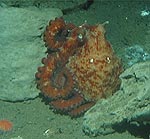 |
 |
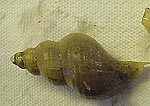 |
 |
 |
Octopod (er)
Enteroctopus dofleini? |
Cranchiid-type squid seen from Alvin at 880m (hr) |
Neptunea humboldtiana or amianta ( er, hr ) |
"Babysitter Snails" |
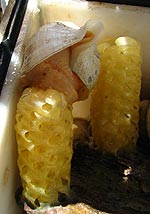 |
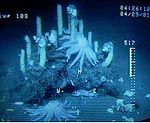 |
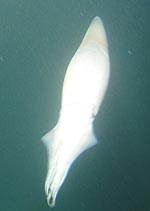 |
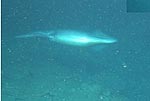 |
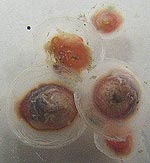 |
"Babysitter Snails"
These Neptunea lay eggs in a spiral tower, sit on the top, then fall off and die once their jobs are done.
|
Various squid seen from Alvin at 500 m (er) |
Tiny limpets found on carbonate rocks (hr) |
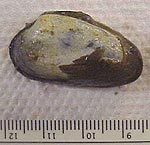 |
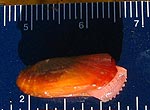 |
 |
 |
 |
| Left: Calyptogena (Vesicomya) pacifica (er); has bacterial symbionts; see SEEPS page for more. Right: Acharax spp. (hr); has bacterial symbionts; see Sahling et al. for more on Vesicomya and Acharax |
A fairytale scene: The egg towers form extensive surreal scenes of "forests" (er 2001,hr 2006). |
Next: Arthropods: Crustacea and Pycnogonida .... |
|